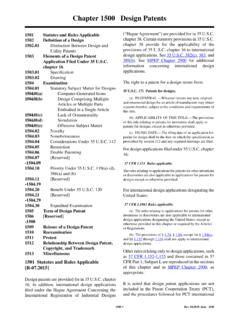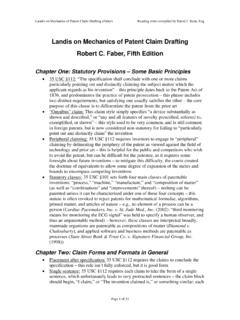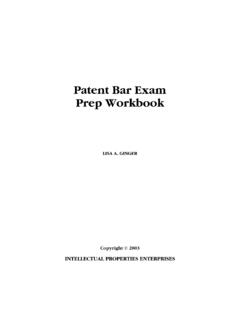Transcription of IT IS IMPROPER TO IMPORT CLAIM LIMITATIONS FROM …
1 IT IS IMPROPER TO IMPORT CLAIM LIMITATIONS FROM THE. specification . "Though understanding the CLAIM language may be aided by explanations contained in the written description, it is important not to IMPORT into a CLAIM LIMITATIONS that are not part of the CLAIM . For example, a particular embodiment appearing in the written description may not be read into a CLAIM when the CLAIM language is broader than the embodiment." Superguide Corp. v. DirecTV Enterprises, Inc., 358 870, 875, 69 USPQ2d 1865, 1868 (Fed. Cir. 2004). See also Liebel- Flarsheim Co. v.
2 Medrad Inc., 358 898, 906, 69 USPQ2d 1801, 1807. (Fed. Cir. 2004)(discussing recent cases wherein the court expressly rejected the contention that if a patent describes only a single embodiment, the claims of the patent must be construed as being limited to that embodiment); E-Pass Techs., Inc. v. 3 Com Corp., 343 1364, 1369, 67 USPQ2d 1947, 1950 (Fed. Cir. 2003) ("Interpretation of descriptive statements in a patent's written description is a difficult task, as an inherent tension exists as to whether a statement is a clear lexicographic definition or a description of a preferred embodiment.)
3 The problem is to interpret claims 'in view of the specification ' without unnecessarily importing LIMITATIONS from the specification into the claims."); Altiris Inc. v. Symantec Corp., 318 1363, 1371, 65 USPQ2d 1865, 1869-70 (Fed. Cir. 2003) (Although the specification discussed only a single embodiment, the court held that it was IMPROPER to read a specific order of steps into method claims where, as a matter of logic or grammar, the language of the method claims did not impose a specific order on the performance of the method steps, and the specification did not directly or implicitly require a particular order).
4 See also paragraph IV, below. When an element is claimed using language falling under the scope of 35 112, 6th paragraph (often broadly referred to as means or step plus function language, the specification must be consulted to determine the structure, material, or acts corresponding to the function recited in the CLAIM . In re Donaldson, 16 1189, 29. USPQ2d 1845 (Fed. Cir. 1994) (see mpep 2181- 2186). In In re Zletz, supra, the examiner and the Board had interpreted claims reading "normally solid polypropylene" and "normally solid polypropylene having a crystalline polypropylene content" as being limited to "normally solid linear high homopolymers of propylene which have a crystalline polypropylene content.)
5 " The court ruled that LIMITATIONS , not present in the claims, were improperly imported from the specification . See also In re Marosi, 710 799, 218 USPQ 289 (Fed. Cir. 1983) ("Claims are not to be read in a vacuum, and LIMITATIONS therein are to be interpreted in light of the specification in giving them their 'broadest reasonable interpretation'." 710 at 802, 218 USPQ at 292 (quoting In re Okuzawa, 537 545, 548, 190 USPQ 464, 466 (CCPA 1976)). (emphasis in original). The court looked to the specification to construe "essentially free of alkali metal" as including unavoidable levels of impurities but no more.)
6 Compare In re Weiss, 989 1202, 26 USPQ2d 1885 (Fed. Cir. 1993) (unpublished decision - cannot be cited as precedent) (The CLAIM related to an athletic shoe with cleats that "break away at a preselected level of force" and thus prevent injury to the wearer. The examiner rejected the claims over prior art teaching athletic shoes with cleats not intended to break off and rationalized that the cleats would break away given a high enough force. The court reversed the rejection stating that when interpreting a CLAIM term which is ambiguous, such as "a preselected level of force", we must look to the specification for the meaning ascribed to that term by the inventor.)
7 " The specification had defined "preselected level of force" as that level of force at which the breaking away will prevent injury to the wearer during athletic exertion).







